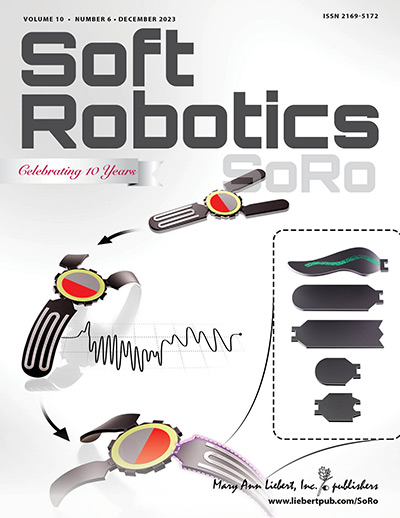空间应用软体机器人:模组金属缆索结构的低温性能。
IF 6.1
2区 计算机科学
Q1 ROBOTICS
引用次数: 0
摘要
软机器人系统由于其嵌入式顺应性、有前途的运动方法以及对质量和体积的有效利用,在各种空间应用中具有很大的前景。太空环境比地球上的环境更加严酷和多变;极端的温度、压力和辐射可能会影响软机器人的性能和鲁棒性。月球或木卫二等天体上的低温对传统软系统的灵活性和驱动性能提出了重大挑战。我们提出了一种软机器人设计方法,使用专门为极端空间环境量身定制的新型金属基软机器人结构。结构呈现为可调的、可重构的软系统模块。用扫描电子显微镜(SEM)研究了模组在液氮环境下的压缩行为和结构变化。结构在-196°C下保持灵活性,在100次循环中峰值刚度增加5%,同时保持全范围运动。利用这些模块构建了一个柔软的机器人肢体,并在-196°C下成功地进行了二维操作和抓取物体。扫描电镜分析显示,低温循环后没有微断裂或变形的物理迹象,表明底层晶粒结构的变化与文献中在低温下观察到的冷加工不锈钢的性能一致。我们的研究结果表明,金属软机器人结构在低温模拟空间环境中保持灵活性并表现出良好的性能。这种基于金属的电缆结构设计方法为开发能够在极端空间环境中工作的功能强大且可重构的软机器人提供了基础。本文章由计算机程序翻译,如有差异,请以英文原文为准。
Soft Robotics for Space Applications: Cryogenic Performance of Modular Metallic Cable Structures.
Soft robotic systems are promising for diverse space applications due to their embedded compliance, promising locomotion methods, and efficient use of mass and volume. Space environments are harsher and more varied than those on Earth; extreme temperature, pressure, and radiation may impact the performance and robustness of soft robots. Cryogenic temperatures on celestial bodies such as the Moon or Europa pose significant challenges to the flexibility and actuation performance of conventional soft systems. We present a soft robotic design methodology using novel metallic-based soft robotic structures specifically tailored to extreme space environments. Structures are presented as tunable, reconfigurable modules for soft systems. Module behavior under compression is characterized while submerged in liquid nitrogen, and structural changes are investigated using scanning electron microscopy (SEM). The structures retained flexibility at -196 °C, with a limited 5% increase in peak stiffness over 100 cycles while maintaining a full range of motion. A soft robotic limb was constructed from these modules and demonstrated successful 2D manipulation and grasping of objects at -196 °C. SEM analysis showed no physical signs of microfracture or deformation after cryogenic cycling, indicating changes to the underlying grain structure consistent with properties observed in cold-working stainless steels at cryogenic temperatures in the literature. Our findings demonstrate that metallic soft robotic structures maintain flexibility and exhibit promising performance in cryogenic, analogue space environments. This metal-based cable structure design approach provides a foundation for the development of functional, robust, and reconfigurable soft robots capable of operating in extreme space environments.
求助全文
通过发布文献求助,成功后即可免费获取论文全文。
去求助
来源期刊

Soft Robotics
ROBOTICS-
CiteScore
15.50
自引率
5.10%
发文量
128
期刊介绍:
Soft Robotics (SoRo) stands as a premier robotics journal, showcasing top-tier, peer-reviewed research on the forefront of soft and deformable robotics. Encompassing flexible electronics, materials science, computer science, and biomechanics, it pioneers breakthroughs in robotic technology capable of safe interaction with living systems and navigating complex environments, natural or human-made.
With a multidisciplinary approach, SoRo integrates advancements in biomedical engineering, biomechanics, mathematical modeling, biopolymer chemistry, computer science, and tissue engineering, offering comprehensive insights into constructing adaptable devices that can undergo significant changes in shape and size. This transformative technology finds critical applications in surgery, assistive healthcare devices, emergency search and rescue, space instrument repair, mine detection, and beyond.
 求助内容:
求助内容: 应助结果提醒方式:
应助结果提醒方式:


